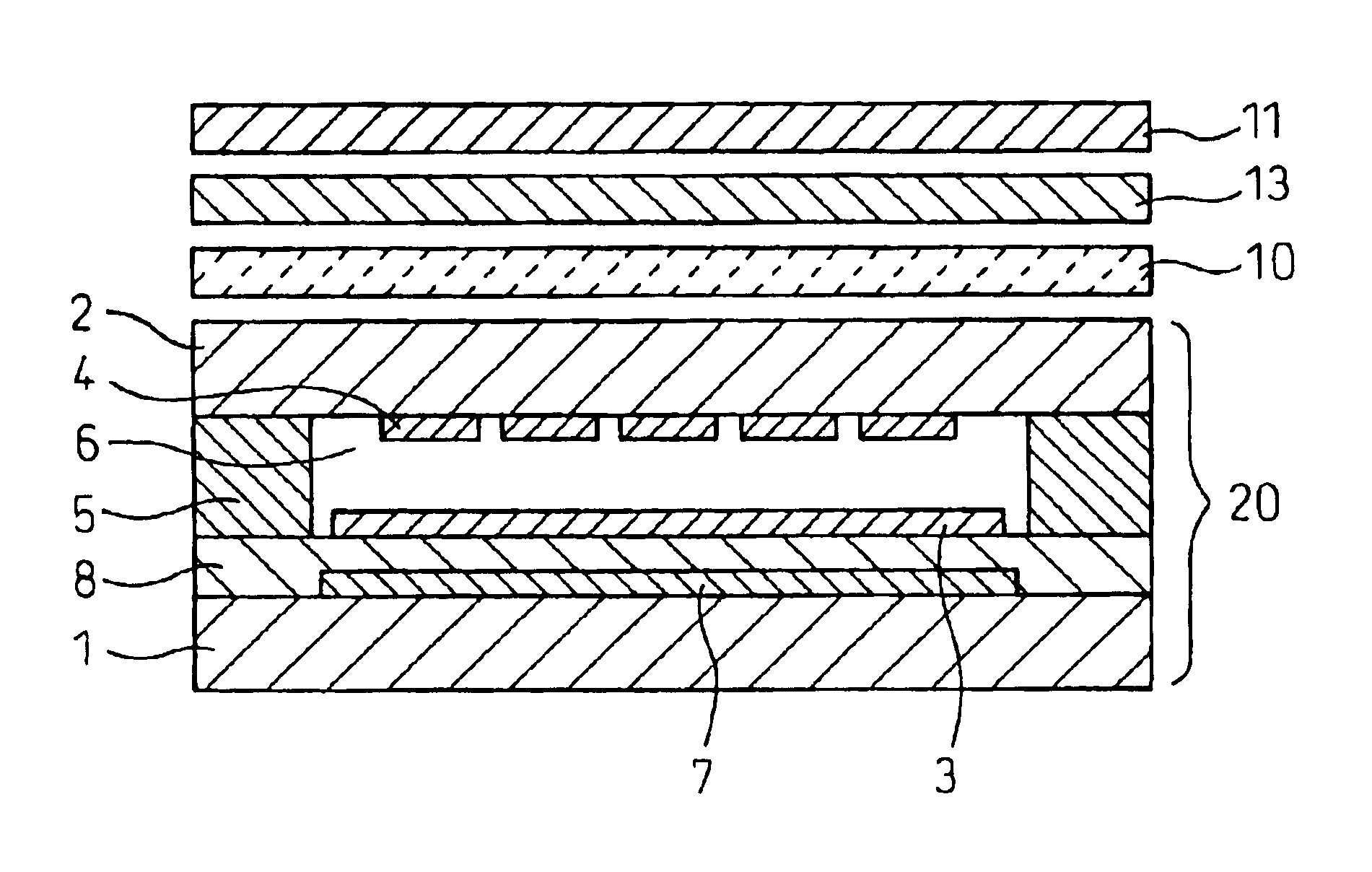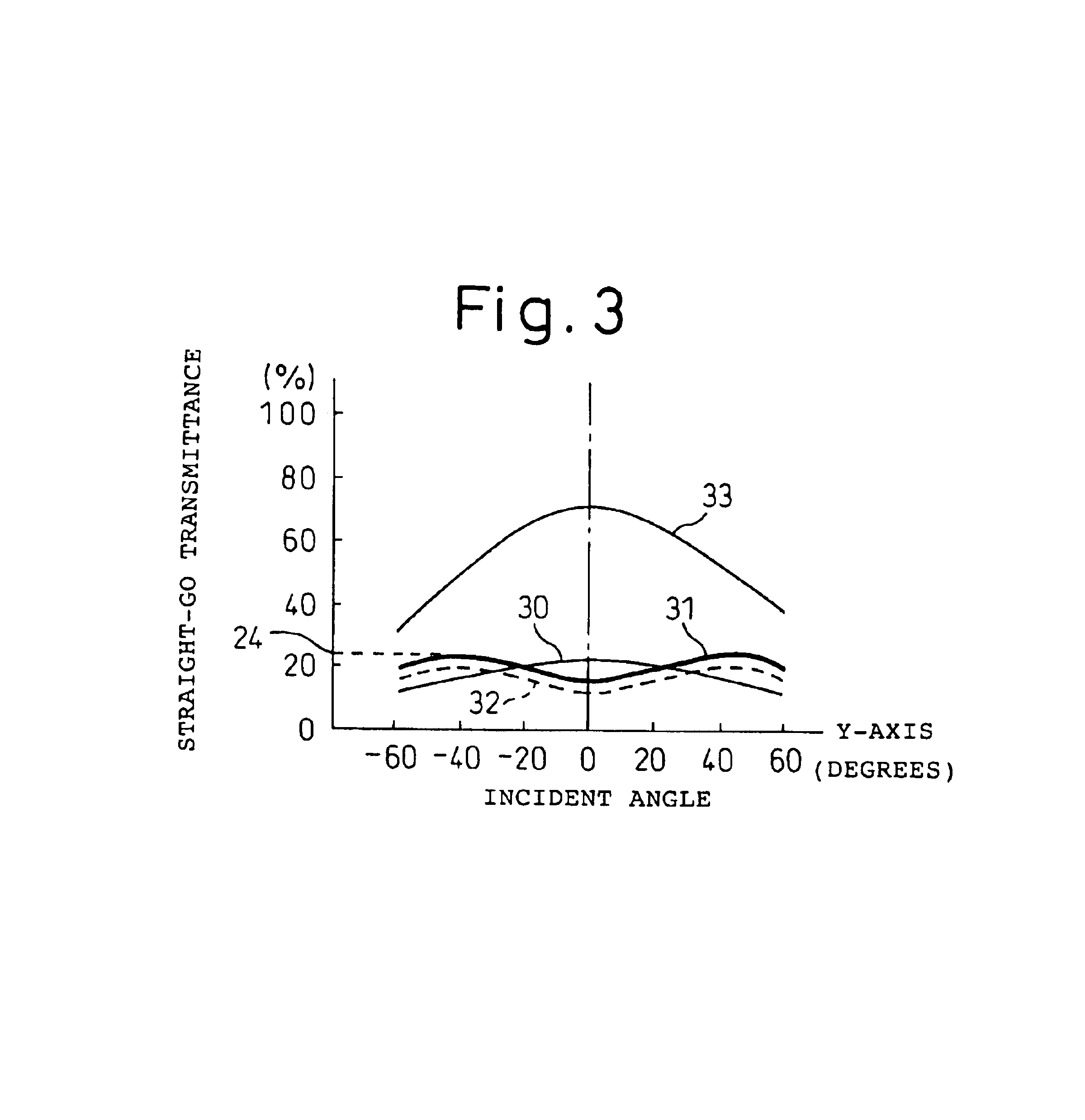Liquid crystal display including an anisotropic scattering layer
a liquid crystal display and anisotropic scattering technology, applied in the field of single-polarizer reflective liquid crystal display, can solve the problems of difficult manufacturing process, low display brightness, shadows appearing on the display, etc., and achieve the effect of good viewing angle characteristi
- Summary
- Abstract
- Description
- Claims
- Application Information
AI Technical Summary
Benefits of technology
Problems solved by technology
Method used
Image
Examples
embodiment 1
[0065]FIG. 7 shows the configuration of a liquid crystal display according to a first embodiment. As shown in FIG. 7, the liquid crystal display comprises a liquid crystal device 20, an anisotropic scattering layer 10 formed on the upper side of the liquid crystal device 20, that is, the side nearer to the viewer and opposite from the side where a reflector is provided, a twisted phase film 12, a first retardation film 13, a second retardation film 14, and a top polarizer 11. In the present embodiment, three retardation films, that is, the twisted retardation film 12, the first retardation film 13, and the second retardation film 14, together constitute the optical compensating element.
[0066]The top polarizer 11, the second retardation film 14, the first retardation film 13, the twisted retardation film 12, and the anisotropic scattering layer 10 are laminated together using an acrylic adhesive, and the anisotropic scattering layer 10 is bonded to the liquid crystal device 20 by usi...
embodiment 2
[0101]Next, a liquid crystal display according to a second embodiment of the present invention will be described below. The configuration of the liquid crystal display of the second embodiment is the same as that shown in FIG. 1. As shown in FIG. 1, the liquid crystal display includes the liquid crystal device 20, the anisotropic scattering layer 10 formed on the side nearer to the viewer than to the reflector, the retardation film 13 as the optical compensating element, and the top polarizer 11. The top polarizer 11, the retardation film 13, and the anisotropic scattering layer 10 are laminated together using an acrylic adhesive, and the anisotropic scattering layer 10 is bonded to the liquid crystal device 20 by using an acrylic resin.
[0102]The configuration of the liquid crystal device 20 is the same as that used in the first embodiment, and therefore, the description of it will not be repeated here.
[0103]The retardation film 13 is a transparent film about 70 μm in thickness form...
embodiment 3
[0123]A third embodiment of the present invention will be described below. The configuration of the liquid crystal display of this embodiment is the same as that shown in FIG. 1, and the configuration of the pixel section is the same as that shown in FIG. 8. Further, the relative orientations of the various component elements are the same as those shown in FIGS. 9 and 13.
[0124]The difference of the liquid crystal display of this embodiment is that the anisotropic scattering layer having the incident angle dependence shown by the curve 34 in FIGS. 5 and 6 is used as the anisotropic scattering layer 10 in the configuration shown in FIG. 1.
[0125]As shown by the curve 34 in FIGS. 5 and 6, the anisotropic scattering layer used in this embodiment has the characteristic that, for both the X-axis and Y-axis directions, the incident angle dependence is the same and is symmetrical about the layer normal. In the case of the anisotropic scattering layer 10 used in the present embodiment and hav...
PUM
 Login to View More
Login to View More Abstract
Description
Claims
Application Information
 Login to View More
Login to View More - R&D
- Intellectual Property
- Life Sciences
- Materials
- Tech Scout
- Unparalleled Data Quality
- Higher Quality Content
- 60% Fewer Hallucinations
Browse by: Latest US Patents, China's latest patents, Technical Efficacy Thesaurus, Application Domain, Technology Topic, Popular Technical Reports.
© 2025 PatSnap. All rights reserved.Legal|Privacy policy|Modern Slavery Act Transparency Statement|Sitemap|About US| Contact US: help@patsnap.com



